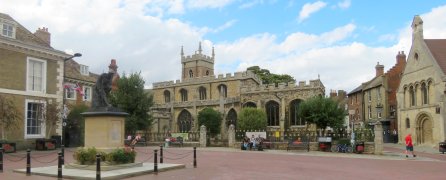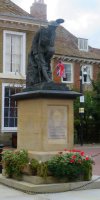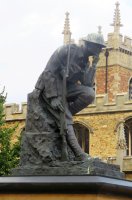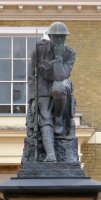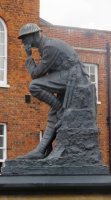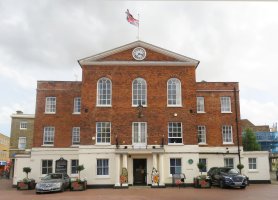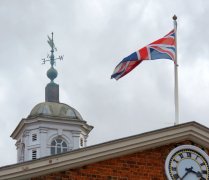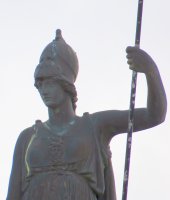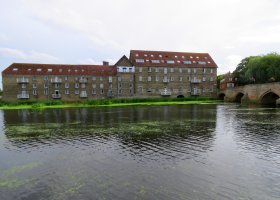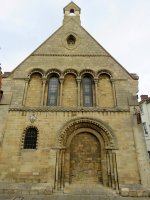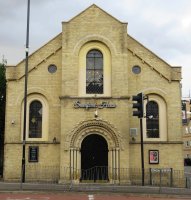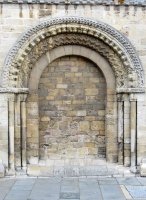Huntingdon Market Square [Market Hill] and High Street
Market Hill, with statue and church.
For sculptural interest in Huntingdon, most significant are the two ancient churches, but there is an interesting war memorial in the market square (called Market Hill), along with Town Hall. One of the two churches, All Saints, occupies one side of the square, and and opposite that is the Cromwell Museum in an ancient building. An amble south-eastwards along the pleasant, humanly-scaled High Street takes us past the former Literary and Scientific Institute with a statue on top of Athena, past the second church, All Saints, and thence to the river with its 14th Century bridge and a view of the mid-Victorian Huntingdon Hosiery Mills buildings, an undecorated but somehow satisfying mass of yellowish brick..
Market Hill
We start with the 1st World War memorial, a bronze, seated soldier, head in hand in a contemplative pose, and known as the Thinking Soldier. There are two sorts of WW1 memorials: those by older artists producing a last flourish of the naturalistic, detailed and often very beautiful, languid sculpture of the turn of the century, and the first of the new, still illustrative but more sketchy, less idealistic and less idealised sculpture of the post-war era. This one dates from 1923, and is decidedly of the latter class. The sculptor was Lady Scott, a portrait sculptor whose best known work is her statue of her husband, Scott of the Antarctic.
Views of Lady Scott's war memorial.
The square as a whole is very picturesque and largely unspoilt. Along one side is All Saints Church, low and with the tower to the far side, so not at all dominating. Behind the statue is Wykeham House, plainish early 19th Century in yellow brick, and between that and the Church, set back, is a late 17th Century building called Walden House. Facing the Church across the square, thus to the left of the war memorial as we look at it, is the Town Hall, of red brick with a nice cupola on the central roof. The frontage to the Square is by the distinguished architect Samuel Pepys Cockerill, dating from 1817-18 (pictured below - click to enlarge), however the rear, including the cupola, is dated 1745 (pictures a bit further down below). It had been put up by voluntary subscription, with large contributions from the Earl of Sandwich and Baron Clarke, and used materials from an older courthouse on the site. The 1817 additions included a colonnade, as shown in our picture further down (click to enlarge), later removed excepting those columns forming the portico.
The northeastern side of the square, the side the statue faces, is a pleasant jumble of brick Century facades, a couple of storeys high, but opposite the church, thus coming out of the square, is the Cromwell Museum, is a surviving remnant of a 12th Century building, with Norman doorway and window, both nicely chevroned (see picture at bottom of page); the sides and rear have been Gothicised and there was work done in the 16th and 19th centuries. It was built as a much larger construction, the Hospital of St John Baptist, founded by David Earl of Huntingdon, likely as almshouses, vaguely Augustinian.
High Street
Carrying on past the Cromwell Museum north and east along High Street, it is pretty enough, but there is little sculptural to be found: a pair of bearded heads on the Nat West building (mid-Victorian, by the architect Frederic Chancellor of Essex, mostly known for his churches), and further on, a care home with a coat of arms. Between these two on the other side of the road is the surviving churchyard of one of Huntingdon's lost churches, St John Baptist, with a few heavy tombs still in situ.
Views of the Athena statue.
If we take the opposite direction, south and east along High Street, then after a modern section, we find a mix of 18th and 19th Century buildings, the first and most imposing being the former Literary and Scientific Institute, put up in 1842, and now called the Commemoration Hall. It was bult by the architects Pocock and Glover, local men: for a monument by them, see the page on St Mary's Church. On top is the statue of Athena (Minerva), with helmet and spear. Going further, takes us past that church, then more older buildings, of architectural but not sculptural interest, with nice doorways. The poet Cowper lived in the building now bearing his name at nos. 29-30.
Huntingdon Hosiery Mills, 1840s, and 14th Century bridge.
Continuing, crossing the main road, straight ahead is the Great Ouse river, and the visitor can stroll further along the bank, allowing opportunity to look back at the side of the ancient bridge, which dates from the early 14th Century. The big building down to the water's edge on the other side of the river is the former Huntingdon Hosiery Mills, dating from the 1840s.
There are various other picturesque buildings in Huntingdon; one grouping on the way to the station is Sandford House, on George Street towards the station, which is the former Chapel of St John the Evangelist, built 1848, which was closely inspired by Cromwell House, especially the Norman doorway; the fine former Post Office next to it was built as the residence of Charles Windover in 1850, and both are owned and have been nicely maintained by Wetherspoons; close by on the other side of the road is the Sebastapol Cannon, a replica, after an earlier cannon commemorating the Huntingdonshire Regiment's engagement in the Crimean War had to be melted down in WW2.
Cromwell Museum and St John the Evangelist Chapel compared.
Also noted on these pages in Huntingdon: St Mary's Church monuments; and All Saints Church monuments.
And also in Cambridgeshire: Peterborough Church monuments
